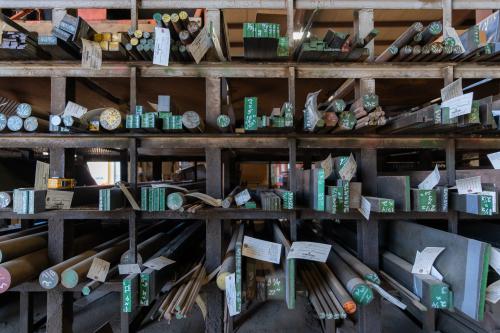Four Types of Steel
Steel is an alloy made up of iron and carbon. The carbon content in the alloy can reach up to 2%, and anything with more carbon content is considered to be cast iron. Elements such as manganese, phosphorus, and sulfur can also be found in most grades of steel. A variety of steels are produced in accordance with the properties required for their application. Various grading systems are used to distinguish these steels based on their properties. Steel is usually categorized into four main groups including carbon steels, alloy steels, stainless steels, and tool steels. Each type has its own unique qualities that make them suitable for different applications.
Types of Steel Grades
Carbon steel gets its name due to the fact that it has minimal other alloying elements. It includes three subtypes: low carbon steels contain about 0.30% carbon, medium carbon steels contain around 0.60% carbon, and high carbon steels are made up of roughly 1.5% carbon. Carbon steels are very strong which is why they are often used for materials in construction equipment and automotive components. Carbon steel accounts for nearly ninety percent of the total steel production industry-wide due to its durable qualities and inexpensive production process.
Alloy steels are a combination of carbon steel and various alloying elements. There are a wide variety of alloy steels; some of the most common include elements such as chromium, cobalt, molybdenum, nickel, tungsten, and vanadium. These alloying elements allow you to manipulate the material's properties including corrosion resistance, strength, hardenability, formability, weldability, and ductility. Alloy steels are commonly used in the production of car parts, pipelines, aircraft and aerospace components, transformers, and other mechanical projects.
Stainless steels are a steel alloy that contain between 10-20% chromium as the main alloying element. Adding chromium to the steel makes it extremely resistant to corrosion, heat, and discoloration. Stainless steel can be broken down into three categories based on the percentage of chromium and other alloying elements it contains. Austenitic steels are non-magnetic and non-heat-treatable, and they contain around 18% chromium, 8% nickel, and less than 0.8% carbon. They make up the largest portion of the global stainless-steel market and common applications include food processing equipment, kitchen utensils, and piping. Ferritic steels contain trace amounts of nickel, 12-17% chromium, less than 0.1% carbon, and some other alloying elements. These steels are magnetic and though they cannot be hardened by heat treatment, they can be strengthened by cold working. Common applications of ferritic steel include auto parts, furnaces, and heat exchangers. The third category of stainless steel is martensitic steels. These are made up of 11-17% chromium, less than 0.4% nickel, and up to 1.2% carbon. Martensitic steels are heat treatable and have magnetic properties. They are most commonly used in the production of knives, cutting tools, and dental and surgical equipment.
The fourth and final steel category is called tool steels. Tool steels contain tungsten, molybdenum, cobalt, and vanadium. They are known for their hardness, as well as their high heat and abrasion resistance. These properties, along with its superior ability to retain its shape, make it an ideal material for composing various tools, which is where the name is derived. Tool steel can be narrowed down into six different categories: water-hardening, cold-work, shock resistant, high-speed, hot-work, and special purpose. Each is used for different machining processes dependent on the specification of the project at hand.
Properties of Different Types of Steel
Steel is a versatile alloy primarily made of iron and carbon, but its properties can vary greatly depending on its composition and processing. There are several types of steel, each tailored for specific applications by altering elements such as carbon, manganese, chromium, nickel, and others. The main categories include carbon steel, alloy steel, stainless steel, and tool steel. Each type has distinct mechanical, chemical, and physical properties that make it suitable for particular industrial and commercial uses.
- Carbon Steel is the most widely used type and is categorized into low, medium, and high carbon steel. Low carbon steel (up to 0.3% carbon) is soft, ductile, and easily welded, making it ideal for structural shapes, automotive panels, and tubing. Medium carbon steel (0.3%–0.6%) offers greater strength and hardness, often used in gears, axles, and machinery parts. High carbon steel (above 0.6%) is very hard and wear-resistant, suited for springs, cutting tools, and high-strength wires, but it's also more brittle and less ductile.
- Alloy Steel contains additional alloying elements such as chromium, nickel, molybdenum, or vanadium. These elements enhance specific properties such as strength, toughness, corrosion resistance, or hardenability. For instance, chromium-molybdenum steels are used in pressure vessels and pipelines due to their ability to withstand high temperatures and pressure. Nickel improves toughness, especially in cold environments, while vanadium increases strength and wear resistance.
- Stainless Steel is known for its corrosion resistance, thanks to its chromium content of at least 10.5%. It's categorized into austenitic, ferritic, and martensitic grades. Austenitic stainless steel (like 304 or 316) is non-magnetic, has excellent corrosion resistance, and is widely used in food processing, medical devices, and marine applications. Ferritic stainless steels are magnetic and more affordable but with moderate corrosion resistance. Martensitic types are hardenable and used for knives, surgical tools, and turbines.
- Tool Steel is designed for high hardness, wear resistance, and heat resistance. These steels are used to make cutting and shaping tools such as dies, drills, and molds. Tool steels are classified into groups like water-hardening (W-grade), cold-work (O, A, D grades), and high-speed steel (T and M grades), each offering specific performance traits under different operating conditions.
The properties of steel types are determined by their chemical composition and processing. Understanding these differences allows engineers, fabricators, and manufacturers to choose the right steel for the right job—balancing cost, strength, durability, and resistance to wear or corrosion.

